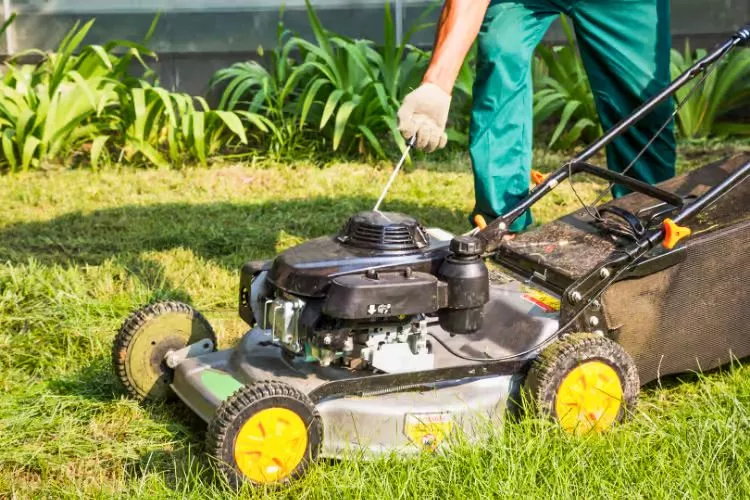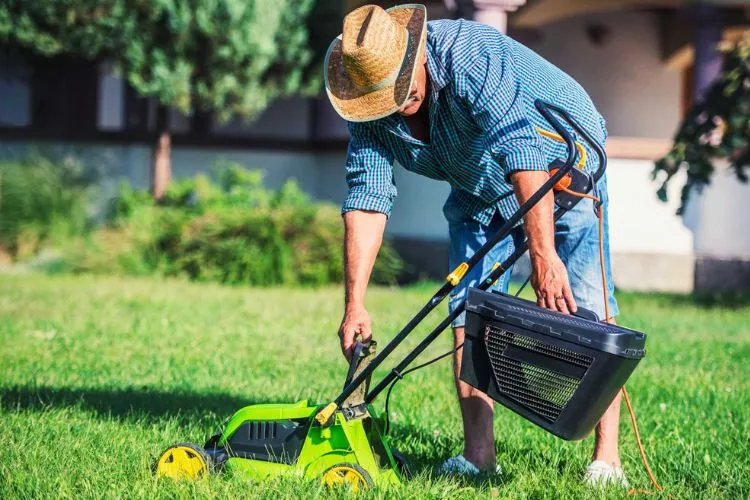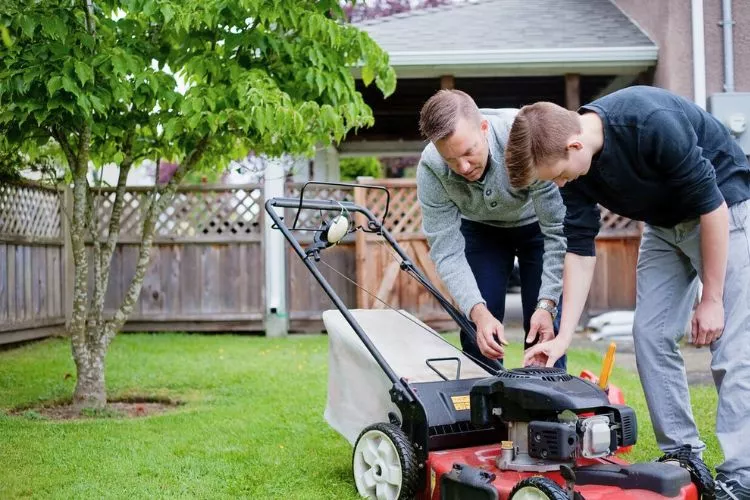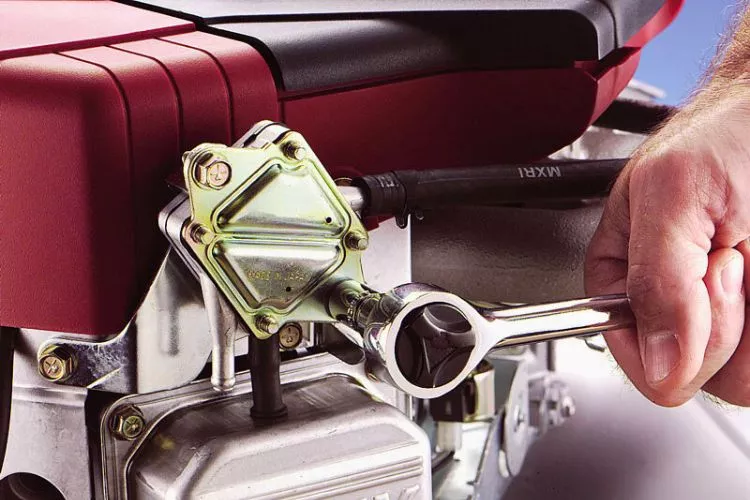You’re not alone if you’ve ever wondered, “Why is my lawn mower backfiring?”.
This startling and often frustrating issue is more common than you think. Backfiring, an abrupt and loud noise resembling a small explosion, often indicates that your lawn mower’s engine isn’t running optimally.
Ignoring it could lead to severe damage and risk to safety, turning a minor irritation into a significant headache.
With common culprits ranging from ignition system glitches to fuel system problems and even mechanical issues, tackling the issue can feel like looking for a needle in a haystack.

But fear not; this comprehensive guide promises to demystify the problem, helping you get back to maintaining your lawn in peace. Stick with us; you’ll soon understand your machine better than ever.
Table of Contents
Why is My Lawn Mower Backfiring? (Causes & Symptoms Explained)
The sudden loud pop of a backfiring lawn mower can turn a tranquil afternoon of yard work into a startling surprise.
But what exactly is backfiring, and what triggers this unexpected racket in your otherwise reliable machine? Let’s dive into the science of lawn mower backfiring.
Definition of backfiring in a lawn mower
Backfiring in a lawn mower occurs when unburned fuel or fuel vapors are ignited somewhere other than the combustion chamber. This combustion can happen in the muffler or exhaust pipe, producing a loud bang or pop.
Although it might sound serious, it’s often a symptom of underlying, easily fixable issues.

Causes of backfiring
A myriad of factors can cause your lawn mower to backfire, ranging from problems in the ignition system to issues with the fuel or even mechanical complications.
Ignition system issues
The ignition system is the heart of your lawn mower’s engine. A well-functioning ignition is essential to start and keep the engine running smoothly. Let’s explore common ignition issues that could cause your mower to backfire.
- Spark Plug Problems: The spark plug plays a crucial role in your lawn mower’s ignition system. It’s responsible for sparking the combustion process within the engine’s cylinder. However, if the spark plug becomes dirty or fouled with carbon, oil, or fuel, it may fail to spark reliably, leading to incomplete combustion. A worn-out spark plug with an eroded or damaged electrode might also struggle to create a strong enough spark. Misfiring or not firing at all can allow unburnt fuel to make its way into the exhaust system, where it could ignite and cause a backfire.
- Ignition Coil Malfunctions: The ignition coil acts like a high voltage transformer, taking the 12-volt power from your mower’s battery and transforming it into the thousands of volts needed to create the spark for combustion. Over time, the coil can deteriorate due to heat and vibration, causing it to produce an intermittent or weak spark. This erratic sparking can lead to incomplete combustion, with some fuel remaining unburnt. This leftover fuel can travel into the exhaust system, ignite, and result in a backfire.
- Flywheel Key Damage: The flywheel key is a tiny yet vital, component of your mower’s engine. It helps synchronize the engine’s ignition system with its internal moving parts, ensuring the spark plug fires correctly. If the mower blade hits a hard object, the sudden jolt can cause the flywheel key to shear or break to protect the engine from damage. However, this also throws the engine’s timing off, causing the spark plug to fire incorrectly. As a result, fuel can end up in the exhaust system, where it ignites and causes a backfire.
- Muffler Problems: The muffler’s primary function is to reduce the noise of exhaust gases exiting the engine. Over time, the muffler can develop issues such as rust or physical damage. If there’s a leak or hole in the muffler, fresh air can mix with the hot exhaust gases. This influx of oxygen can ignite any unburnt fuel within the exhaust gases, causing an explosion or backfire. Additionally, a damaged muffler will not effectively muffle the sound of a backfire, making the noise more startling.
Fuel system problems
Your mower’s fuel system can also cause backfiring if it’s not running optimally. Here are some potential culprits in this category.
- Clogged Carburetor: The carburetor in your lawn mower plays a critical role in mixing air and fuel to create the perfect combustible cocktail for your engine. Over time, however, small particles of dirt, debris, or old fuel can clog up the tiny orifices inside the carburetor, disrupting the balance of air and fuel. If the carburetor sends too much or too little fuel into the engine, it can result in incomplete combustion, leaving unburnt fuel that can ignite in the exhaust system and cause a backfire.
- Improper Fuel Mixture: The proper fuel-to-air ratio in your lawn mower’s engine is crucial for complete combustion. An incorrect ratio can result in either a lean or rich condition. A lean condition (too much air, not enough fuel) can cause the engine to run hot and may lead to backfiring, especially when the engine is abruptly throttled down. On the other hand, a rich condition (too much fuel, not enough air) can result in unburnt fuel being expelled into the exhaust system, where it can ignite and cause a backfire.
- Dirty Air Filter: The air filter’s job is to ensure that the air entering your engine is clean and debris-free. However, if the filter becomes clogged or dirty, it can restrict airflow into the carburetor. This restriction disrupts the engine’s air and fuel balance, potentially leading to incomplete combustion and a subsequent backfire. Besides causing backfires, a dirty air filter can also lead to power loss and decreased fuel efficiency in your mower.
- Fuel with Alcohol: Today, many fuels contain ethanol (a form of alcohol), particularly in the U.S. Although this is usually fine for your car, small engines like those in lawnmowers can struggle with these blended fuels. Ethanol can cause the engine to run hotter and draw moisture into the fuel. This can lead to several problems, including a higher chance of backfire, as the increased engine heat can cause fuel to ignite prematurely. Additionally, alcohol-blended fuels can degrade and form deposits faster, potentially leading to a clogged carburetor.
Mechanical issues
Mechanical issues may not be as common as fuel or ignition system problems, but they are just as capable of causing backfires. Let’s delve into some of these issues.
- Valve Problems: Your lawn mower’s engine valves are critical in operation. The intake valve allows the air-fuel mixture into the combustion chamber, while the exhaust valve lets out the exhaust gases after combustion. If either valve doesn’t open or close at the right time or gets stuck due to carbon build-up, it can disrupt combustion. For instance, an intake valve that doesn’t close properly might allow some air-fuel mixture to escape into the exhaust system. Or, an exhaust valve that doesn’t open on time could cause some unburnt fuel to remain in the cylinder. These conditions can lead to incomplete combustion and cause fuel to ignite in the exhaust system, resulting in a backfire.
- Engine Timing Issues: The timing of your lawn mower’s engine is crucial for its smooth operation. It ensures that the spark plug ignites the air-fuel mixture precisely when the piston is at the top of its stroke. This allows the ensuing explosion to exert the maximum possible force on the piston, driving it down and turning the crankshaft. However, if the engine’s timing is off, it can cause the spark plug to fire either too early or too late. Early ignition (pre-ignition) can cause the mixture to ignite while the intake valve is still open, pushing some of the ignited gases back into the intake manifold. Late ignition, however, can leave some unburnt fuel in the cylinder, which can ignite in the exhaust system. Both scenarios can lead to backfiring.
- Incomplete Combustion: Incomplete combustion occurs when the air-fuel mixture in the engine’s cylinder doesn’t burn fully. This can happen for various reasons, including a rich fuel mixture, insufficient air supply, spark plug problems, or timing issues. When combustion is incomplete, some fuel remains unburnt and can be expelled into the exhaust system. The high temperatures in the exhaust can ignite this unburnt fuel, causing a backfire.
Symptoms of backfiring
Aside from the obvious loud popping sound, there are other telltale signs that your lawn mower is backfiring.

Popping or banging noise
The most characteristic symptom of a backfire is a loud popping or banging noise from the exhaust system. It’s a bit like the sound of a gunshot or firecracker.
This noise results from an explosion outside the engine’s combustion chamber, typically in the muffler or the exhaust pipe.
This explosion is caused by the ignition of unburnt fuel that has made its way into the exhaust system. If your lawn mower is backfiring, you will likely hear these noises either while the engine is running or after you shut it off.
Loss of power
A backfiring engine is often not running optimally, which can lead to a noticeable loss of power. This power loss may manifest as a slower cutting speed or difficulty mowing on inclines that your mower would typically handle easily.
Backfiring can be a sign of several issues, like problems with the fuel or ignition systems or engine timing issues, all of which can impact your mower’s performance and power.
Therefore, if your lawn mower seems to be struggling or doesn’t have the same power as before, and you hear the telltale pop of backfire, these issues are likely related.
Exhaust smoke changes
Changes in the color or amount of exhaust smoke can often accompany backfiring and provide valuable clues as to the cause.
For instance, black smoke indicates a rich fuel mixture, meaning too much fuel and insufficient air. This excessive fuel can lead to incomplete combustion and backfiring.
Blue or white smoke, conversely, can signal oil burning in the combustion chamber, another condition that can lead to backfiring. If your mower is backfiring and you notice a change in the exhaust smoke, note it, as this can help diagnose the problem.
Troubleshooting and Solutions
Knowing a backfiring lawn mower’s potential causes and symptoms is only half the battle. The next and possibly most important step is learning how to troubleshoot these issues and apply effective solutions.
This section guides you through the practical steps to diagnose and fix problems related to your mower’s ignition system, fuel system, and mechanical parts.

With patience and the right approach, you’ll be well on your way to restoring your lawn mower’s performance, ensuring it runs smoothly and efficiently again.
Remember, safety first: Always ensure your mower is off and cooled down before you start any troubleshooting or maintenance tasks. Now, let’s dive in!
Ignition System
The ignition system plays a crucial role in your mower’s operation. It’s responsible for igniting the air-fuel mixture in the engine’s cylinder at the right moment, a key factor for smooth and efficient combustion.
But, like any system, it can run into issues, which could lead to backfiring. We’ll focus on three key components here: the spark plugs, ignition coil, and flywheel key.
Spark plug problems
The spark plug is the component that produces the spark needed to ignite the air-fuel mixture. If your spark plug is worn out, dirty, or not gapped correctly, it might not produce a strong enough spark, leading to incomplete combustion and potentially backfiring.
Key Notes: To check your spark plug, remove it from the engine (ensure the engine is off and cool) and inspect it for wear or buildup. If it appears worn out or dirty, it might be best to replace it. Spark plugs are inexpensive, and replacing them can often resolve backfiring issues.
Pro Tips: When installing a new spark plug, gap it correctly. The gap is between the center and side electrodes, where the spark forms. The owner’s manual should specify the correct gap for your mower’s spark plug. A spark plug gap tool can help you set this accurately. Regular maintenance of your spark plugs can prevent issues down the line.
Ignition coil malfunctions
The ignition coil generates the high voltage required to create a spark. If it’s malfunctioning, it might not produce enough voltage, leading to a weak or no spark, causing incomplete combustion.
Key Notes: You can test your ignition coil using a multimeter. If the resistance readings are outside the values specified in the owner’s manual, it’s likely that the coil is faulty and needs to be replaced.
Pro Tips: During installation of the new coil, inspect the insulation to ensure no cracks or damage could cause voltage leaks. Also, ensure the coil is correctly grounded to the engine block for optimal operation.
Flywheel key damage
The flywheel key is a small metal piece that aligns the flywheel correctly for precise ignition timing. If your mower has been subjected to a sudden stoppage, like hitting a rock, the flywheel key can shear to prevent more severe engine damage.
Key Notes: A sheared flywheel key can delay the engine’s timing, leading to backfiring. Inspect the flywheel key if your mower has recently had a hard stop. If it’s damaged, it will need to be replaced.
Pro Tips: Ensure the replacement flywheel key is torqued to the manufacturer’s specifications. Proper flywheel alignment is critical for correct engine timing and preventing future backfires.
Fuel System
The fuel system of your lawn mower is crucial for its operation, as it delivers the right amount of fuel to the combustion chamber. Issues in the fuel system, such as a clogged carburetor, an improper fuel mixture, or a dirty air filter, can all lead to an improper fuel-air mixture.

This, in turn, can result in incomplete combustion and a backfire. Let’s walk through these issues and discuss how to tackle them.
Clogged carburetor
The carburetor is the heart of your lawn mower’s fuel system. It mixes fuel and air in the proper ratio for combustion. However, deposits can build up over time and clog the carburetor, disrupting this delicate balance and leading to backfires.
Key Notes: If your mower is backfiring, the carburetor is one of the first things to check. You can clean it using a carburetor cleaner spray or a special solution. You may need to replace it if it’s heavily clogged or damaged.
Pro Tips: Using a fuel stabilizer can prevent fuel from degrading and leaving deposits in the carburetor. Regular maintenance, including occasional cleaning, can keep your carburetor working efficiently and prevent clogs.
Improper fuel mixture
An improper fuel mixture, either too rich (too much fuel) or too lean (too much air), can lead to incomplete combustion, with unburnt fuel entering the exhaust system and causing a backfire.
Key Notes: Check your mower’s fuel if you suspect an improper fuel mixture. Old, stale fuel can lead to a poor fuel-air mixture. Also, check the carburetor settings, as they control the fuel-air ratio.
Pro Tips: Always use fresh fuel for your lawn mower, and store it properly to prevent degradation. If you’re unsure about adjusting the carburetor, consider getting help from a professional.
Dirty air filter
The air filter ensures that the air entering the carburetor is clean and free of debris. A dirty or clogged air filter can restrict airflow, resulting in a rich fuel mixture and potential backfiring.
Key Notes: Regularly check and clean the air filter. If it’s too dirty or damaged, replace it.
Pro Tips: Regular inspection and maintenance of the air filter can help keep the fuel mixture in the correct balance and prevent backfiring. Always have a replacement air filter on hand to ensure optimal performance.
Mechanical Issues
Sometimes, the problem causing a lawn mower to backfire may not lie within the fuel or ignition system but could be related to mechanical issues. The culprits often involve valve problems and engine timing issues. Let’s dive deeper into these points.

Valve problems
The valves in your lawn mower’s engine play a crucial role in controlling the intake of the fuel-air mixture and the exhaust of burnt gases. If the valves don’t close properly, some unburnt fuel might enter the exhaust system, causing a backfire.
Key Notes: If you notice your lawn mower backfiring, inspect the valves. They might need adjusting to open and close at the right times.
Pro Tips: Maintain the proper valve clearance to ensure good performance and prevent backfiring. Regular lubrication of the valves can also help them operate smoothly. You might want to have a small engine mechanic do this if you’re not comfortable doing it yourself.
Engine timing issues
The timing of the engine’s firing sequence is crucial for smooth operation. If the timing is off, it can cause the fuel-air mixture to ignite at the wrong time, potentially leading to a backfire.
Key Notes: Diagnosing engine timing problems can be tricky. They can be due to various factors, including a worn-out timing belt or a malfunctioning timing chain.
Pro Tips: If you suspect your lawn mower is backfiring due to engine timing issues, you might need professional help. Engine timing is complex and requires expert knowledge to fix.
Mechanical issues can be challenging to diagnose and fix, especially if you’re not familiar with the inner workings of your lawn mower’s engine.
However, regular maintenance can prevent many problems and keep your mower running smoothly.
Frequently Asked Questions (fAQs)
How do I clean a clogged carburetor in my lawn mower?
First, remove the carburetor from your mower. Use a carburetor cleaner spray to remove any deposits or use a cleaning solution if it’s heavily clogged. Once cleaned, reinstall it.
Is it necessary to replace the air filter to fix backfiring?
Replacing the air filter isn’t always necessary. However, if it’s overly dirty or damaged, a new air filter can help prevent backfiring by ensuring proper air-fuel mixtures for combustion.
How often should I inspect and adjust the valves in my lawn mower?
Valve inspection and adjustment should be part of your regular maintenance routine. Ideally, check them at the start of each mowing season or after every 25 hours of operation.
When should I seek professional help for backfiring issues?
Seek professional help if basic troubleshooting doesn’t resolve the backfiring or if you’re uncomfortable performing certain tasks, like adjusting engine timing or dealing with complex mechanical issues.
What does a lawn mower backfire sound like?
A lawn mower backfire typically sounds like a loud bang or popping noise, somewhat similar to a gunshot. It’s often accompanied by a puff of smoke from the exhaust.
Conclusion
Proper maintenance and timely lawn mower troubleshooting can prevent backfiring, ensuring smooth and efficient operation.
In this guide, we delved into the causes and symptoms of backfiring, along with effective solutions, ranging from ignition system checks to fuel mixture adjustments and mechanical fixes.
Remember, prompt resolution of these issues is key to extending your mower’s lifespan. We hope that this guide has been helpful.
You can read about similar topics here on our website. Check back again soon for more. Stay green, stay efficient!


